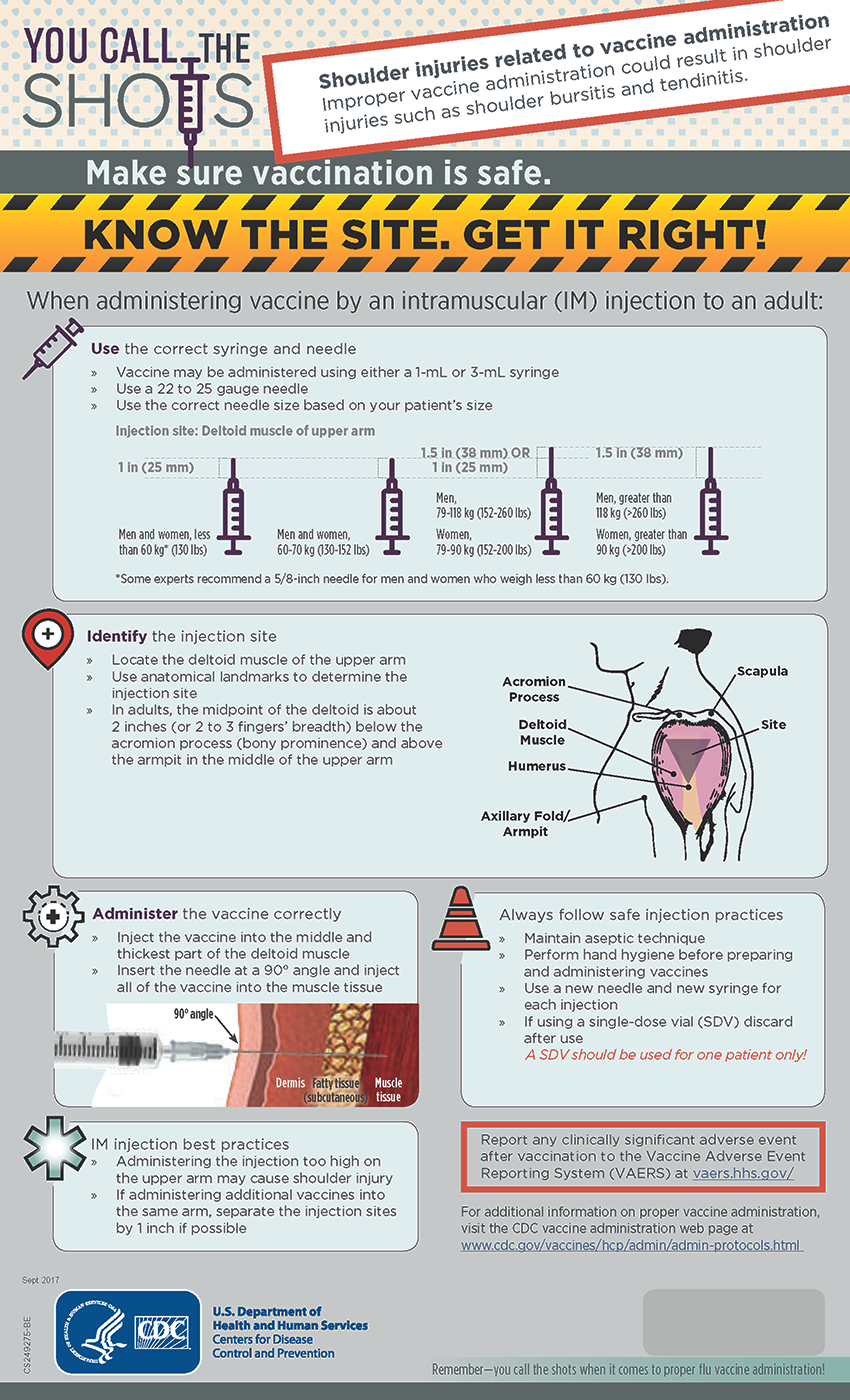You Call the Shots Infographic
- Read Text Equivalent (for Section 508 access).
- Print this infographic [1 page].

You Call the Shots (text equivalent)
Shoulder injuries related to vaccine administration
Improper vaccine administration could result in shoulder injuries such as shoulder bursitis and tendinitis.
Make sure vaccination is safe.
Know the site. Get it right!
When administering vaccine by an intramuscular (IM) injection to an adult:
Use the correct syringe and needle [image of a syringe]
- Vaccine may be administered using either a 1-mL or 3-mL syringe
- Use a 22 to 25 gauge needle
- Use the correct needle size based on your patient’s size
[Image: needle lengths based on the patient’s size]
| Age group | Needle length |
|---|---|
| Men and women, less than 60 kg (130 lbs) | 1 inch (25 mm)* |
| Men and women, 60–70 kg (130–152 lbs) | 1 inch (25 mm) |
| Men, 70–118 kg (152–260 lbs) | 1–1.5 inches (25–38 mm) |
| Women, 79–90 kg (152–200 lbs) | |
| Men, greater than 118 kg (260 lbs) | 1.5 inches (38 mm) |
| Women, greater than 90 kg (200 lbs) |
*Some experts recommend a 5/8-inch needle for men and women who weigh less than 60 kg.
[Image: a location icon]
Identify the injection site
- Locate the deltoid muscle of the upper arm
- Use anatomical landmarks to determine the injection site
- In adults, the midpoint of the deltoid is about 2 inches (or 2 to 3 fingers’ breadth) below the acromion process (bony prominence) and above the armpit in the middle of the upper arm
[Image: graphic identifying the acromion process, deltoid muscle, humerus, axillary fold/armpit, scapula, and the site]
[Image: gear with a plus sign at the center]
Administer the vaccine correctly
- Inject the vaccine into the middle and thickest part of the deltoid muscle
- Insert the needle at a 90 degree angle and inject all of the vaccine into the muscle tissue
[Image: syringe with the needle inserted into the muscle tissue at a 90 degree angle. The image identifies the dermis, fatty tissue (subcutaneous), and muscle tissue]
[image: traffic cone]
Always follow safe injection practices
- Maintain aseptic technique
- Perform hand hygiene before preparing and administering vaccines
- Use a new needle and new syringe for each injection
- If using a single-dose vial (SDV) discard after use
A SDV should be used for one patient only!
[Image: asterisk]
IM injection best practices
- Administering the injection too high on the upper arm may cause shoulder injury.
- If administering additional vaccines into the same arm, separate the injection sites by 1 inch if possible.
Report any clinically significant adverse event after vaccination to the Vaccine Adverse Event Reporting System (VAERS).
For additional information on proper vaccine administration, visit the CDC vaccine administration web page.
[FOOTER BANNER] Remember—you call the shots when it comes to proper flu vaccine administration!
[CDC LOGO] [STATE HEALTH DEPT LOGO]
Source: General Best Practice Guidelines for Immunization
[logo] U.S. Department of Health and Human Services, Centers for Disease Control and Prevention
CS249275-BE | Sept 2017
- Page last reviewed: September 21, 2017
- Page last updated: September 21, 2017
- Content source:


 ShareCompartir
ShareCompartir